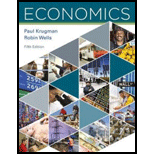
Concept Introduction:
Marginal Propensity to Consume (MPC): It is the proportion of amount which the consumer pays for consumption of goods and services, and it does not include the savings of the consumer.
Formula to calculate money multiplier:
Here:
- MPC in marginal propensity to consume.
Formula to calculate recessionary/inflationary gap:
Negative value shows inflationary gap whereas positive value shows recessionary gap.
Formula to calculate required change in government purchases:
Formula to calculate transfer per dollar:
Here:
- MPC in marginal propensity to consume.
Formula to calculate change in the government transfers:
a. Change in government spending and government transfer.
Given:
Real GDP equals $100 billion.
Potential output equals $160 billion.
Marginal propensity to consume is 0.75.
Substitute 0.75 for MPC in (I):
Substitute $160 billion for potential output and $100 billion for real output in (II):
Substitute $60 billion for recessionary gap and 4 for money multiplier in (III):
Substitute 0.75 for MPC in (IV):
Substitute $60 billion for recessionary gap and $3 for transfer per dollar in (V):
Therefore, there is a rise in government spending by $15 billion and there should be increase in government transfers by $20 billion.
Explanation of Solution
Conclusion:
Thus, rise in government spending is by $15 billion and government transfers by $20 billion.
b. Effect on Real GDP when MPC is 0.5.
Given:
Real GDP equals $250 billion.
Potential output equals $200 billion.
Marginal propensity to consume is 0.5.
Substitute 0.75 for MPC in (I):
Substitute $160 billion for potential output and $100 billion for real output in (II):
Substitute $60 billion for recessionary gap and 4 for money multiplier in (III):
Substitute 0.75 for MPC in (IV):
Substitute $60 billion for recessionary gap and $3 for transfer per dollar in (V):
Therefore, there is a fall in real GDP by $50 billion and there should be a decrease in government transfers by $25 billion.
Conclusion:
Thus, a fall in real GDP by $50 billion and decrease in government transfers by $25 billion.
c. Effect on Real GDP when MPC is 0.8.
Given:
Real GDP equals to $180 billion.
Potential output equals to $100 billion.
Marginal propensity to consume is 0.8.
Substitute 0.8 for MPC in (I):
Substitute $100 billion for potential output and $180 billion for real output in (II):
Substitute $80 billion for recessionary gap and 5 for money multiplier in (III):
Substitute 0.8 for MPC in (IV):
Substitute $80 billion for recessionary gap and $4 for transfer per dollar in (V):
Therefore, there is a fall in real GDP by $80 billion and there should be a decrease in government transfers by $20 billion.
Conclusion:
Thus, there is a a fall in real GDP by $80 billion and a decrease in government transfers by $20 billion.
Want to see more full solutions like this?

 Principles of Economics (12th Edition)EconomicsISBN:9780134078779Author:Karl E. Case, Ray C. Fair, Sharon E. OsterPublisher:PEARSON
Principles of Economics (12th Edition)EconomicsISBN:9780134078779Author:Karl E. Case, Ray C. Fair, Sharon E. OsterPublisher:PEARSON Engineering Economy (17th Edition)EconomicsISBN:9780134870069Author:William G. Sullivan, Elin M. Wicks, C. Patrick KoellingPublisher:PEARSON
Engineering Economy (17th Edition)EconomicsISBN:9780134870069Author:William G. Sullivan, Elin M. Wicks, C. Patrick KoellingPublisher:PEARSON Principles of Economics (MindTap Course List)EconomicsISBN:9781305585126Author:N. Gregory MankiwPublisher:Cengage Learning
Principles of Economics (MindTap Course List)EconomicsISBN:9781305585126Author:N. Gregory MankiwPublisher:Cengage Learning Managerial Economics: A Problem Solving ApproachEconomicsISBN:9781337106665Author:Luke M. Froeb, Brian T. McCann, Michael R. Ward, Mike ShorPublisher:Cengage Learning
Managerial Economics: A Problem Solving ApproachEconomicsISBN:9781337106665Author:Luke M. Froeb, Brian T. McCann, Michael R. Ward, Mike ShorPublisher:Cengage Learning Managerial Economics & Business Strategy (Mcgraw-...EconomicsISBN:9781259290619Author:Michael Baye, Jeff PrincePublisher:McGraw-Hill Education
Managerial Economics & Business Strategy (Mcgraw-...EconomicsISBN:9781259290619Author:Michael Baye, Jeff PrincePublisher:McGraw-Hill Education





